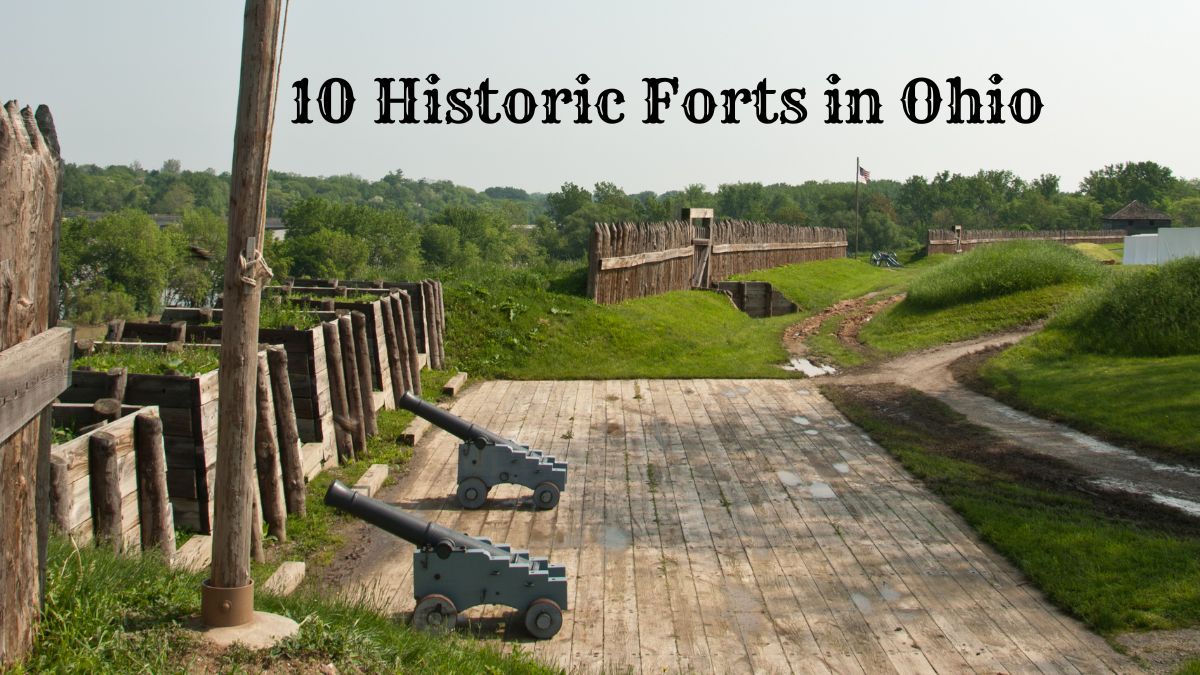In the heartland of America, where history meets topography, the “Historic Forts in Ohio” are enduring symbols of a bygone era.
Each fort, with its aged ramparts and timeworn stone, echoes tales of bravery, strategy, and cultural encounters.
As we delve into this article, we journey back to pivotal moments that shaped the nation, moments forever immortalized by these stoic structures. Join us as we traverse Ohio’s landscapes, where every fort narrates a chapter of the grand American saga.
10 Historic Forts in Ohio
| 1. Fort Washington (1789) | 6. Fort Amanda (1812) |
| 2. Fort Recovery (1793) | 7. Fort Meigs (1813) |
| 3. Fort Steuben (1786) | 8. Fort Defiance (1794) |
| 4. Fort Loramie (1769) | 9. Fort Huntington (1813) |
| 5. Fort Jefferson (1791) | 10. Fort Wayne (1794) |
1. Fort Washington (1789)
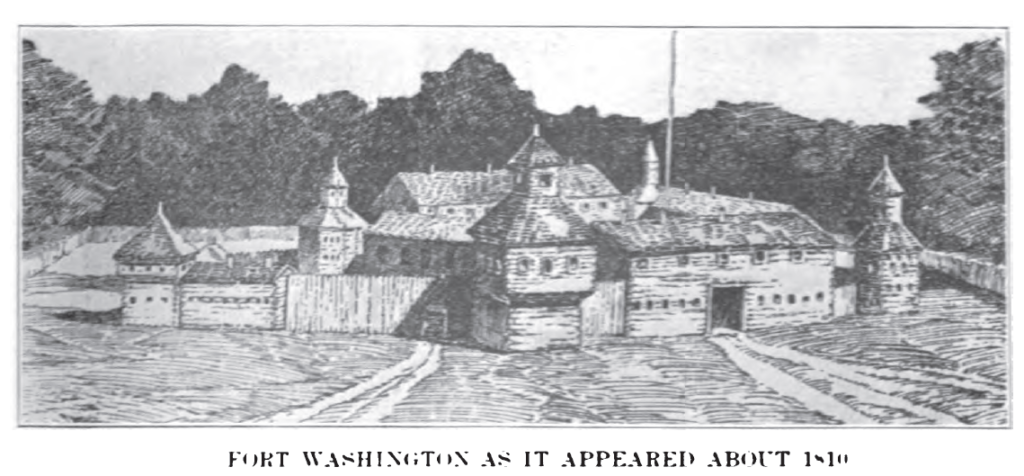
In the heart of Cincinnati, a stone’s throw away from the bustling streets and modern skyscrapers once stood Fort Washington. A historic emblem of the late 18th century, this fort is more than just walls and cannons; it’s a testament to the turbulent times that Ohio witnessed and the indomitable spirit of its early settlers.
In the late 18th century, as settlers moved westward to pursue new opportunities, they inevitably came into conflict with Native American tribes, who had inhabited these lands for centuries. As tensions escalated, there was an evident need for a stronghold to protect settlers and serve as a strategic point against potential threats.
The Establishment of Fort Washington
In response to this need, Fort Washington was established in the 1780s, under the command of General Josiah Harmar. Situated at a vantage point overlooking the Ohio River, it quickly symbolized American might and determination in the region.
While General Harmar played a pivotal role in its inception, the fort also witnessed the leadership of notable figures like General “Mad” Anthony Wayne and General Arthur St. Clair. Both made significant contributions to the military campaigns originating from the fort.
Fort Washington’s Role in U.S. Army Campaigns
Beyond serving as a protective shield for settlers, Fort Washington earned its mark as a crucial supply depot for the U.S. Army during its campaigns against Native Americans. The fort provided resources and logistical support, ensuring the army was well-equipped for expeditions.
Under the leadership of General Harmar in 1790 and General St. Clair in 1791, the fort was the launching point for significant expeditions against Native American tribes. However, both campaigns met with significant resistance, with St. Clair’s defeat being one of the most significant losses for the U.S. Army during the Northwest Indian War.
Following these setbacks, “Mad” Anthony Wayne took the helm. Using Fort Washington as his base, Wayne trained a professional army, leading them to victory at the Battle of Fallen Timbers in 1794. This victory was pivotal, culminating in the signing of the Treaty of Greenville in 1795, which brought a semblance of peace to the region.
2. Fort Recovery (1793)

As the 18th century drew to a close, the western frontier of the newly formed United States was anything but settled. The area, which is now Ohio, was particularly tumultuous.
Amidst the vast wilderness and fertile plains, Native American tribes resisted the encroachment of American settlers, leading to frequent clashes and the necessity for fortified outposts. One such fortress was Fort Recovery.
Construction and Strategic Importance
Built-in 1793 under the orders of General “Mad” Anthony Wayne, Fort Recovery was strategically positioned near the Wabash and St. Mary’s Rivers’ confluence. The fort’s primary objective was to serve as a protective garrison and a logistical base for American forces, ensuring they maintained a foothold in the region against Native American tribes.
The Battles at Fort Recovery
Less than a year after its establishment, Fort Recovery became the epicenter of a significant conflict. In June 1794, a coalition of Native American tribes, led by Miami Chief Little Turtle and Shawnee Chief Blue Jacket, laid siege to the fort.
The two-day battle saw the American forces successfully defend the fort despite being heavily outnumbered, largely due to its sturdy construction and strategic position.
St. Clair’s Defeat (November 1791)
Although this event predates the fort’s construction, the location is historically significant for being the site of General Arthur St. Clair’s devastating defeat by Native American forces in November 1791.
This loss, the U.S. Army’s worst against Native American forces, prompted the construction of Fort Recovery two years later, marking the site’s importance.
Key Personnel and Turning Points
Fort Recovery’s significance is also underscored by the notable figures who passed through its gates. General Wayne, already renowned for his military prowess, used the fort to help train and reorganize the U.S. Army following St. Clair’s defeat.
His efforts culminated in the subsequent Battle of Fallen Timbers in 1794, which led to the signing of the Treaty of Greenville—a treaty that dramatically changed the region’s dynamics.
Legacy of Fort Recovery
Today, the village of Fort Recovery stands as a testament to these historical events. The fort may no longer dominate the landscape, but markers, monuments, and a museum ensure its stories are not forgotten.
Visitors can retrace the steps of soldiers and warriors, gaining insights into the frontier tensions that shaped the nation’s westward expansion.
3. Fort Steuben (1786)

The late 18th century was a period of uncharted challenges and vast opportunities in the budding United States. The Northwest Territory, a vast tract acquired post the American Revolutionary War, beckoned with its promise of fertile lands.
However, charting this new territory was perilous due to tensions with Native American tribes. This called for fortifications to protect those who dared to map the nation’s future, leading to the construction of Fort Steuben.
Rising Walls and Strategic Intent
Erected in 1786, Fort Steuben stood proudly in the city of Steubenville, Ohio. Named in honor of the Prussian drillmaster Baron Friedrich Wilhelm von Steuben, who had significantly aided the Continental Army during the Revolutionary War, the fort was not just a military outpost. It symbolized the American aspiration to expand and grow.
Its primary purpose was to provide protection to surveyors who had undertaken the monumental task of laying out the first seven ranges of public lands in the Northwest Territory. These lands represented the beginning of organized westward expansion by the fledgling United States.
Key Figures and Fort Steuben’s Role
The daunting task of surveying the territory was entrusted to Thomas Hutchins, the nation’s first Geographer of the United States, and his team.
Their work was critical in translating the Land Ordinance 1785 from paper to reality. As they meticulously plotted townships and lands, Fort Steuben provided them with the safety and security they needed against potential threats from local Native American tribes.
The Legacy of Fort Steuben and the Northwest Territory
While the fort was temporary and stood for only a few years, its impact lasted. The surveying it protected laid the groundwork for the orderly expansion of the United States, setting a precedent for public land distribution.
Today, Steubenville honors this historic fort’s legacy with the Fort Steuben Museum, where visitors can immerse themselves in the world of 18th-century surveyors, soldiers, and pioneers. Artifacts, dioramas, and detailed exhibits provide a window into the challenges and achievements of that era.
4. Fort Loramie (1769)
Amid Ohio’s dense forests and sprawling waterways, the British established several trading posts in the 18th century, facilitating commerce and negotiations with Native American tribes.
One such establishment was what would later become Fort Loramie. Situated strategically, this trading post became an intersection of cultures, economies, and aspirations.
American Transition and Fortification
As the winds of change swept through North America, post the Revolutionary War, territories shifted hands. The late 1700s saw the American forces, keen on establishing a stronger foothold in the region, taking over several British outposts. Fort Loramie was no exception.
Upon its acquisition, the Americans, realizing its strategic location and the growing tensions with Native American tribes, fortified the former trading post. Under the guidance of American military strategists, Fort Loramie was transformed into a formidable stronghold, ready to withstand the challenges of the frontier.
The 1790s: A Decade of Conflict
The transition from a trading post to a military fort came at a crucial time. The 1790s were marred by conflicts between the United States and a confederation of Native American tribes, known as the Indian Wars. These battles were driven by territorial disputes and the Native American tribes’ desire to resist American expansion.
Fort Loramie played a pivotal role during these tumultuous times. It served as a base for American troops and provided shelter, supplies, and a strategic advantage for planning and launching expeditions. The fort’s presence was a deterrent, showcasing the United States’ commitment to asserting its regional dominance.
Key Personnel and Events
Many significant figures in American military history crossed the thresholds of Fort Loramie during this period. Leaders, strategists, and frontline soldiers alike recognized the importance of this fort in the broader theater of conflict.
While several skirmishes and confrontations occurred in its vicinity, the fort symbolized American resilience and determination.
Fort Loramie’s Legacy
While the brick-and-mortar of the original structure might have faded with time, Fort Loramie’s legacy remains intact.
Today, it is a reminder of the complex interplay of trade, territory, and tensions in the late 18th century. It is a testament to the transformation of a trading post into a pivotal military installation, echoing the larger narrative of a young nation’s westward aspirations.
5. Fort Jefferson (1791)

In the heart of the burgeoning American frontier, as tensions mounted between the new nation’s settlers and the Native American tribes that had inhabited the lands for centuries, strategic outposts became paramount.
Established in 1791 near the modern town of Greenville, Fort Jefferson stood as one of these essential bastions. Designed not only as a fortress of defense but also as a logistical heart, it played a critical role in the military maneuvers of the time.
A Strategic Supply Point
The vast wilderness of the Ohio frontier presented numerous challenges for American military campaigns, not the least of which was ensuring a steady flow of supplies to troops in the field. Fort Jefferson was strategically positioned to serve this purpose.
As a supply depot, it facilitated the movement of provisions, armaments, and reinforcements, ensuring that the American forces never found themselves without essential resources.
General Arthur St. Clair and His Campaign
General Arthur St. Clair, a seasoned military leader with experience from the Revolutionary War, was tasked with a significant mission in the early 1790s. He was to lead a campaign against the Western Confederacy—a powerful alliance of Native American tribes that resisted American expansion into their territories.
Fort Jefferson became indispensable as St. Clair and his troops embarked on their campaign. Serving as a pivotal supply depot, it backed St. Clair’s forces, ensuring they had the necessary supplies for their expedition.
Moreover, its presence offered a semblance of security, a place where wounded could be treated and weary soldiers could find reprieve.
The Challenges and Aftermath
Despite the strategic positioning and the support from forts like Jefferson, St. Clair’s campaign faced significant challenges. The Native American forces, under leaders like Little Turtle and Blue Jacket, proved formidable opponents. St. Clair’s subsequent defeat at their hands in 1791 was a stark reminder of the complexities of frontier warfare.
However, the legacy of Fort Jefferson persisted. Despite the setback, the fort was a logistical point for the region’s future campaigns and military endeavors.
Fort Jefferson Today: A Symbol of Perseverance
Time might have eroded the physical structures of Fort Jefferson, but its significance in American history remains undiminished. Today, it stands as a testament to the strategic foresight of the early American military and the challenges they faced in expanding the nation’s frontier.
6. Fort Amanda (1812)
The early 19th century brought fresh challenges to a young American nation still finding its footing on the global stage. The War of 1812, from maritime disputes with Great Britain, expanded to the American frontier.
Amidst this backdrop of conflict and strategic maneuvering rose Fort Amanda, an embodiment of American resilience and strategic brilliance.
A Fort on the Frontier
Constructed during the heart of the War of 1812, Fort Amanda found its home along the picturesque banks of the Auglaize River. This location was chosen not just for its natural beauty but also for the strategic advantage it presented.
The riverways of Ohio, teeming with potential, became crucial transportation and supply routes for the U.S. forces, and Fort Amanda was poised perfectly to oversee and facilitate this.
Supplying the American Endeavor
The war, while largely naval at its core, had significant land-based theaters of conflict, especially along the American frontier. Supply lines became the lifelines for these battlegrounds.
Fort Amanda, with its fortifications and infrastructure, became one such crucial lifeline. As a supply depot, it ensured that American troops, whether engaging British forces or their Native American allies, were never left wanting for resources.
Provisions, weaponry, ammunition, and other crucial supplies flowed through Fort Amanda, destined for the hands of soldiers who stood at the forefront of defending American sovereignty. Its presence bolstered the morale and capability of the U.S. forces, making it an unsung hero of the war.
The Legacy of Fort Amanda
While the War of 1812 eventually concluded with the Treaty of Ghent in 1814, the impact of forts like Amanda lingered. They served as reminders of the nation’s capability to rally, even in times of adversity, and underscored the importance of logistics and preparation in military campaigns.
Today, the site of Fort Amanda stands as a monument to that pivotal time in American history. Visitors can almost hear the echoes of soldiers marching, feel the weight of the supplies that passed through, and appreciate the strategic foresight that birthed this fort.
7. Fort Meigs (1813)
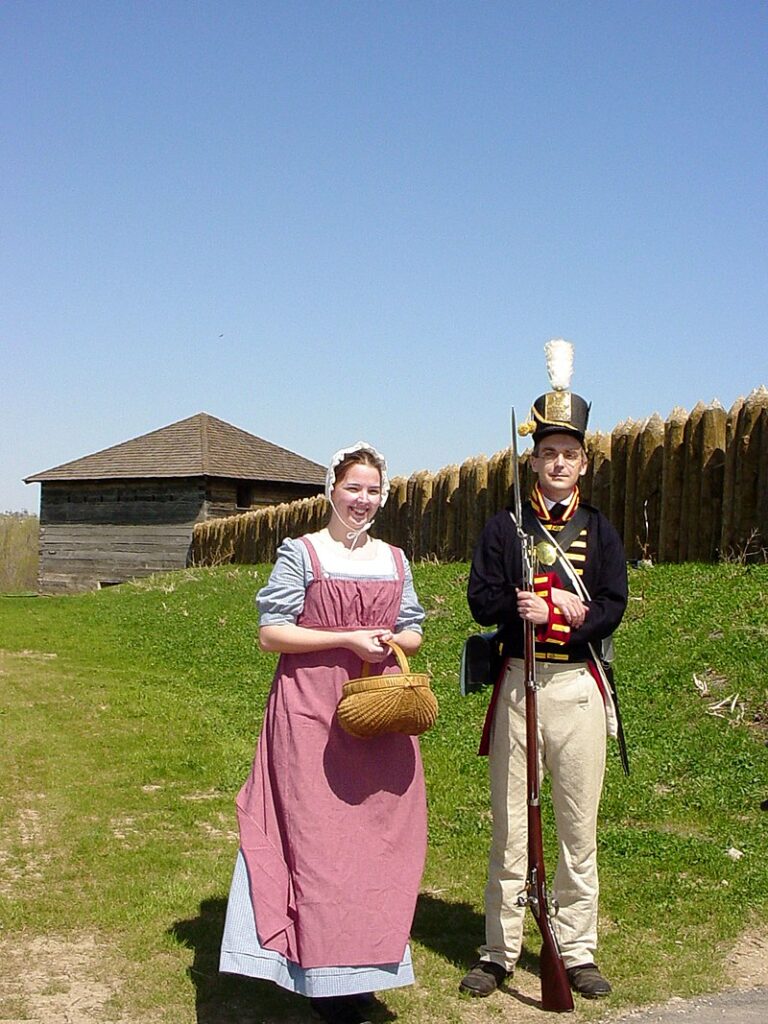
The tumultuous War of 1812 saw American soil become the stage for numerous battles and confrontations.
In the heartland of Ohio, as British and Native American forces sought to gain the upper hand, the United States Army rose to the challenge, constructing a series of fortifications to fend off the imminent threats. Among these was the formidable Fort Meigs.
Strategically Situated Strength
Perched strategically in what is now known as Perrysburg, Fort Meigs was not just any military outpost. Envisioned as a stronghold against the approaching British and Native American forces, its strategic location allowed the U.S. Army to maintain control over the crucial Maumee River, a vital transportation and supply route.
The Dual Sieges of Fort Meigs
In the War of 1812 history, few fortifications can boast the distinction of successfully withstanding not one, but two sieges. Fort Meigs earned this honor with aplomb.
The first siege, in the spring of 1813, saw British General Procter and his Native American allies, under the leadership of the famed Tecumseh, attempt to wrest control of the fort. However, under the determined leadership of American General William Henry Harrison, the fort’s defenders held their ground, repelling the assault.
A few months later, in July, the British and Native American forces returned, hopeful to capitalize on a weakened American defense. Yet, Fort Meigs, a symbol of American resilience, stood unyielding, successfully repelling this second assault.
Fort Meigs Today: A Legacy Preserved
The wars eventually end, but their stories linger. Today, Fort Meigs is not just a chapter in a history book but a tangible state memorial. The reconstructed fort offers visitors a vivid journey back in time. The towering walls, the soldiers’ quarters, and the battle scars all whisper tales of bravery, strategy, and endurance.
Educational exhibits, reenactments, and guided tours at the memorial ensure that the heroic tales of those who defended the fort, and the significance of the sieges it withstood are passed down to generations.
8. Fort Defiance (1794)
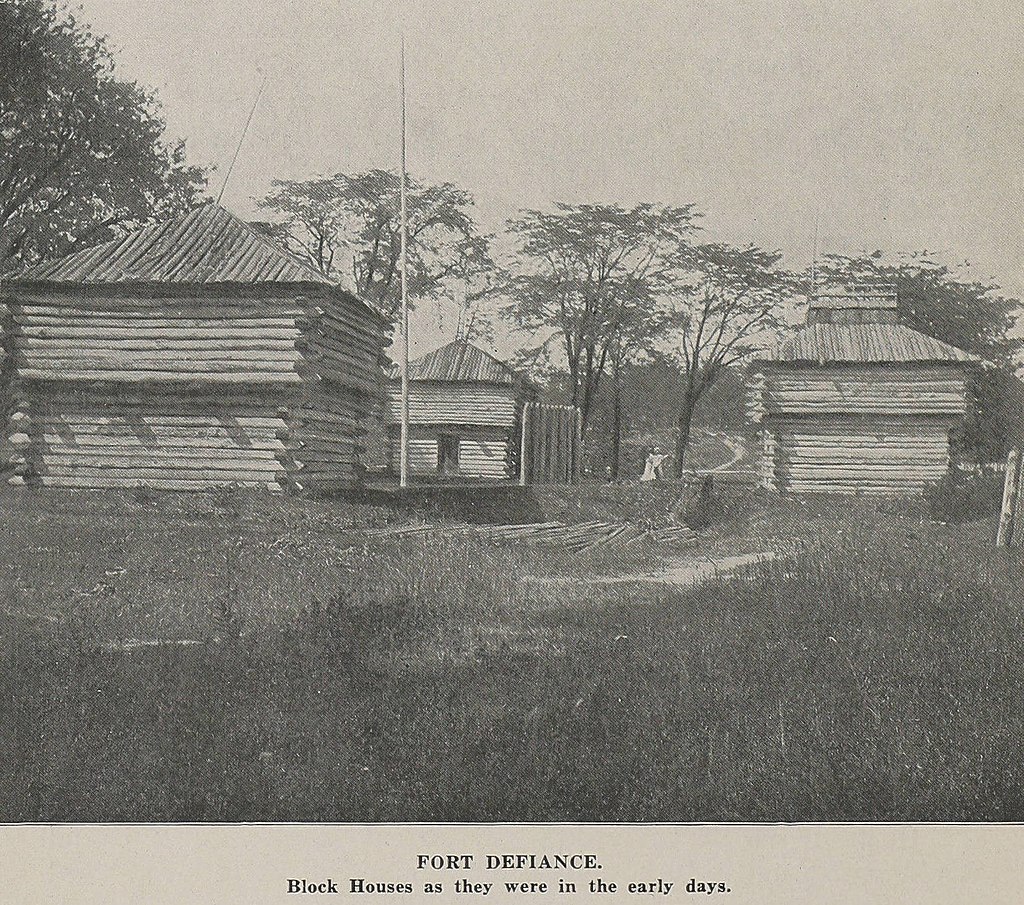
As the fledgling United States began to stretch its wings westward, the vast Ohio frontier emerged as both a land of promise and a cauldron of conflict. With Native American tribes fiercely defending their territories against encroaching settlers, military strategy and fortifications became vital. Amidst this backdrop of tension and ambition, Fort Defiance was born.
The Genius of “Mad” Anthony Wayne
General Anthony Wayne, often referred to as “Mad” Anthony Wayne for his bold and daring tactics, was a military leader whose reputation preceded him.
Recognizing the need for a stronghold to solidify American positions in the region, he set his sights on the confluence of the Maumee and Auglaize Rivers—a location of both strategic importance and symbolic significance.
Founding of Fort Defiance
In 1794, under Wayne’s watchful eye, Fort Defiance took shape. Its strategic position at the river confluence made it a logistical marvel, allowing for efficient troops, supplies, and information movement. Moreover, its very presence at this crossroads of waterways sent a clear message: the American forces were here to stay.
Wayne’s Campaign Against the Western Confederacy
The Western Confederacy, a powerful alliance of Native American tribes, had long been a formidable force resisting American expansion. Wayne, with Fort Defiance as a key base of operations, began his campaign to challenge this Confederacy.
The fort provided a launch point for military expeditions and acted as a defensive bulwark against potential retaliatory strikes. Its strategic value became even more apparent during the pivotal Battle of Fallen Timbers, where Wayne’s forces, leveraging their fortified positions, secured a decisive victory.
Fort Defiance in Modern Memory
Today, the town of Defiance stands as a testament to the fort’s enduring legacy. While the original structures of Fort Defiance may have faded with time, its spirit and significance have not. With its rich history, the town continues to draw visitors, historians, and those keen on understanding the dynamics of early American frontier life.
9. Fort Huntington
Fort Huntington was strategically situated in what is now known as Cleveland, Ohio. Built in 1813, it was a testament to the tumultuous times during the War of 1812.
The fort was constructed on the grounds of a previous settlement, Cleveland, which had tragically been burned down during the early stages of the war. Named in honor of Samuel Huntington, the then-governor of Ohio, the fort symbolized a beacon of hope and defense in uncertain times.
War of 1812
The War of 1812, which saw the young United States grappling with the British Empire, marked a period of intense vulnerability for frontier settlements.
Fort Huntington, in particular, played a pivotal role during this war. As part of the U.S. military’s northern defense line, it served to deter potential British attacks. Its establishment and presence were instrumental in securing the American frontier, acting as a bulwark to protect settlers and the budding communities in the region.
However, as with many constructs of war, once peace was restored, the immediate need and relevance of such forts began to wane.
Following the War of 1812, the surrounding land of Fort Huntington saw an influx of settlers and burgeoning development. As Cleveland grew and evolved, the fort was eventually dismantled, making way for the urban sprawl and the city’s expansion.
Fort Huntington Today
Today, while no physical remnants of Fort Huntington stand in Cleveland, its historical significance is not forgotten. The fort’s legacy is woven into the fabric of Cleveland’s history, serving as a stark reminder of the early challenges the United States faced in its journey to secure its borders and ensure the well-being of its people.
10. Fort Wayne (1794)
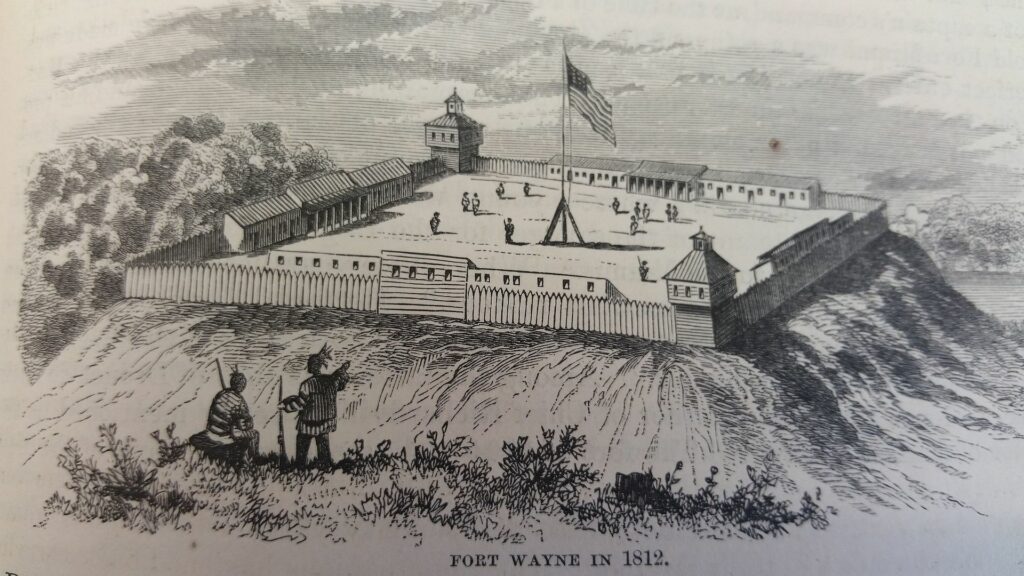
Located in the heart of the Midwest, the vast landscapes of Ohio have borne witness to countless tales of ambition, conflict, and nation-building.
Among these tales stands the story of Fort Wayne, a sentinel in the wilds of the Western Frontier and a name that would eventually christen an entire city.
Origins and Strategic Significance
As tensions escalated in the late 18th century between Native American tribes and encroaching American settlers, the need for fortified positions became paramount.
Recognizing this, General “Mad” Anthony Wayne, fresh from his successes with Fort Defiance, established Fort Wayne in 1794.
Located near the convergence of the Maumee, St. Mary’s, and St. Joseph Rivers, the fort’s position was strategically chosen to control the pivotal waterways and solidify the American presence in the Northwest Territory.
A Bulwark Against Native American Confederacies
In its early years, Fort Wayne served as a critical deterrent against Native American forces, particularly the Western Confederacy. Its stout walls, manned by determined soldiers, ensured that the surrounding lands remained under American control.
The fort’s establishment played an instrumental role in the subsequent Treaty of Greenville in 1795, which saw many present-day Ohio and Indiana ceded by Native American tribes to the United States.
Fort Wayne’s Evolution
The threat of conflict waned as the years rolled on, but Fort Wayne’s significance did not diminish. The fort evolved from a military outpost into a bustling trading post, fostering commerce and facilitating interactions between settlers and Native Americans.
The community that sprouted around Fort Wayne began to flourish, and by the mid-19th century, it had grown into a thriving town. Recognizing its roots, the town adopted the name “Fort Wayne,” a nod to its foundational military post and the visionary general who established it.
Related: 10 Historic Forts in Oklahoma
Preservation and Tourism
The Importance of Maintaining These Historic Sites
Ohio’s historical forts, from Fort Wayne on the banks of the Maumee River to Fort Defiance, where the Auglaize River flows, remind us of the sacrifices made by the early settlers and the Native Americans who originally inhabited the Ohio Country.
The American Revolution and subsequent conflicts saw places like Fort Steuben become vital supply depots. These forts, many located at strategic locations along major rivers such as the Ohio River, played a pivotal role in American control of the region.
Efforts by the state of Ohio, with the support of local communities and organizations like the Ohio Historical Society, have made substantial strides in preserving the original sites of these forts. Fort Ancient, a prehistoric site in the Great Miami River Valley, is an example of Ohio’s dedication to preserving even its most ancient structures.
Adjacent museums and visitors centers, like the Fort Steuben Visitor Center, provide detailed insights, with original items displayed alongside modern copy prints for tourists to understand the depth of Ohio’s role in North America’s history.
The benefits of these preservation efforts extend beyond mere nostalgia. They serve as vital educational hubs, teaching visitors about everything from the British invasion during the War of 1812 to the Northwest Indian War.
Furthermore, heritage tourism has become a significant contributor to local economies. Sites close to the Muskingum River or the Mississippi Valley attract thousands annually, eager to explore the legacy left behind by figures like General “Mad” Anthony Wayne and Arthur St. Clair.
Visiting the Forts Today
While some forts like the Old Stone Fort are remnants of the past, many have been revitalized for modern visitors. Amenities often include parking lots, museum shops, and even occasional reenactments showcasing the British Army’s confrontations with the United States Army or local militia.
Annual events at places like Fort Meigs, supported by associations such as the Fort Meigs Association, offer reenactments of battles like the Battle of Lake Erie, giving visitors a taste of pivotal turning points in history.
Fort Loramie, Fort Recovery, and Fort Jefferson, all located in Western Ohio, come alive with stories of early trading posts and the tumultuous times when Great Britain and the young American forces vied for control of the Great Lakes region.
Tourists walking on the east sides of these forts can still see small mounds or remains of artillery batteries, a testament to the forts’ defensive capabilities.
Related: 10 Historic Forts in Pennsylvania
Conclusion – Historic Forts in Ohio
The enduring significance of Ohio’s historic forts is evident in every square stockade, every adjacent museum, and every preserved county road leading up to them.
From Fort Huntington’s tales of naval fleets to the exact location of Fort Findlay, the state’s commitment to preserving these landmarks showcases its understanding of the value of history.
The efforts of figures like General Harrison, George Croghan, and many others, are immortalized in these forts, ensuring that the tales of American victory, the challenges faced during British cannon fire, and the everyday life of those stationed at these military posts are not forgotten.
As the years go by, Ohio continues its commitment to these sites, ensuring that future generations from Columbus or New York can journey back in time and understand the tapestry of events that shaped the nation.
If you have visited any of these forts in Ohio we would love to hear about your experience in the comments section below.

Cory is a website owner and content creator who enjoys fishing, history, coin collecting, and sports, among other hobbies. He is a husband and father of four.
Romans 15:4 For whatever was written in former days was written for our instruction, that through endurance and through the encouragement of the Scriptures we might have hope.

